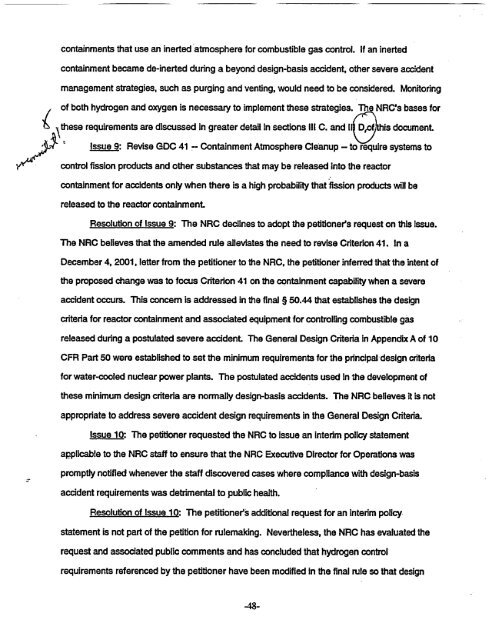SECY-03-0127 - NRC
SECY-03-0127 - NRC
SECY-03-0127 - NRC
You also want an ePaper? Increase the reach of your titles
YUMPU automatically turns print PDFs into web optimized ePapers that Google loves.
containments that use an inerted atmosphere for combustible gas control. If an inerted<br />
containment became de-inerted during a beyond design-basis accident, other severe accident<br />
management strategies, such as purging and venting, would need to be considered. Monitoring<br />
of both hydrogen and oxygen is necessary to implement these strategies. The <strong>NRC</strong>'s bases for<br />
these requirements are discussed in greater detail In sections III C. and 11 is document.<br />
Issue 9: Revise GDC 41 - Containment Atmosphere Cleanup - to require systems to<br />
control fission products and other substances that may be released into the reactor<br />
containment for accidents only when there is a high probability that fission products will be<br />
released to the reactor containment.<br />
Resolution of Issue 9: The <strong>NRC</strong> declines to adopt the petitioner's request on this issue.<br />
The <strong>NRC</strong> believes that the amended rule alleviates the need to revise Criterion 41. In a<br />
December 4, 2001, letter from the petitioner to the <strong>NRC</strong>, the petitioner inferred that the intent of<br />
the proposed change was to focus Criterion 41 on the containment capability when a severe<br />
accident occurs. This concern is addressed in the final § 50.44 that establishes the design<br />
criteria for reactor containment and associated equipment for controlling combustible gas<br />
released during a postulated severe accident. The General Design Criteria in Appendix A of 10<br />
CFR Part 50 were established to set the minimum requirements for the principal-design criteria<br />
for water-cooled nuclear power plants. The postulated accidents used In the development of<br />
these minimum design criteria are normally design-basis accidents. The <strong>NRC</strong> believes it is not<br />
appropriate to address severe accident design requirements in the General Design Criteria.<br />
Issue 10: The petitioner requested the <strong>NRC</strong> to issue an interim policy statement<br />
applicable to the <strong>NRC</strong> staff to ensure that the <strong>NRC</strong> Executive Director for Operations was<br />
promptly notified whenever the staff discovered cases where compliance with design-basis<br />
accident requirements was detrimental to public health.<br />
Resolution of Issue 10: The petitioner's additional request for an interim policy<br />
statement is not part of the petition for rulemaking. Nevertheless, the <strong>NRC</strong> has evaluated the<br />
request and associated public comments and has concluded that hydrogen control<br />
requirements referenced by the petitioner have been modified in the final rule so that design<br />
-48-
















